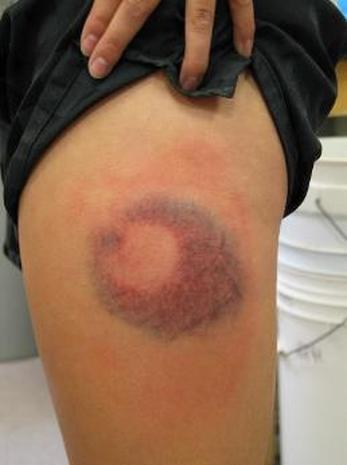|
It's rugby season so I’ve had a few players with muscle contusions - which we commonly call “corks”. Corks result from a severe impact to a muscle, usually from an opposition player’s knee or elbow. The blow mechanically damages muscle fibres, directly at the site of impact, and/or deeper in the tissue through compressing it against the underlying bone. This causes bleeding, swelling, stiffness, pain, and difficulty contracting the muscle.
Most corks are in the quadriceps (thigh muscle), but I also see corks to the glutes, calf, back muscles, and biceps. Corks can be graded I, II, or III, reflecting the severity of the injury. A player with a Grade I cork will finish the game, despite having some pain and stiffness. I wouldn’t expect a Gd I cork to visibly bruise or cause a limp, and I wouldn’t expect the player to miss any subsequent weeks of play. |
A player with a Grade II cork will have too much pain to finish the game. I’d expect significant pain, stiffness, walking with a limp, a visible bruise, and to miss the next 2 to 3 weeks of games. As a rough guide I use the number of days limping as a predictor for the number of weeks until return to play.
A player with a Gd III cork will have difficulty weight-bearing, severely restricted range of movement, and will miss at least 6 weeks of games.
A player with a Gd III cork will have difficulty weight-bearing, severely restricted range of movement, and will miss at least 6 weeks of games.
Initial management of the injury is crucial. Of the RICE acronym (Rest, Ice Compression, Elevation), the most important component is compression. The muscle fibres are bleeding internally in a similar way as being stabbed with a knife. If you’d been stabbed you wouldn’t reach for an ice pack. The first thing you’d do is put pressure on the wound to get it to stop bleeding. Similarly with a cork I really like to get firm compression on it ASAP.
For a cork in the thigh I apply the ice with the knee bent as far as possible because the muscle quickly stiffens up. Not a painful quads stretch, but definitely have the knee bent up in front while icing. 20 minutes every hour with the ice pack as often as possible over the first 48 hours.
I recommend only the gentlest stretching in the first week. 30 second holds of a pain-free stretch, six times per day.
For a cork in the thigh I apply the ice with the knee bent as far as possible because the muscle quickly stiffens up. Not a painful quads stretch, but definitely have the knee bent up in front while icing. 20 minutes every hour with the ice pack as often as possible over the first 48 hours.
I recommend only the gentlest stretching in the first week. 30 second holds of a pain-free stretch, six times per day.
I like to start some muscle loading exercises from day one, so the muscle knows it needs to lay down new muscle fibres as part of the healing process. Simple body weight strengthening exercises to get the muscle contracting and relaxing. Squats, lunges, step ups/downs, and isometrics, depending on what is achievable without significant pain.
The damaged muscle starts to repair within the first few days after injury. Unfortunately, in an effort to rebuild with a stronger type of tissue, the body lays down fibrous collagen tissue (scar tissue). The scar is structurally stronger than the muscle fibres but is not functional, contractile tissue. In an effort to rebuild more resistant to impact the muscle sacrifices functional strength.
To minimize the amount of scar tissue I like a high repetition / low resistance loading program of literally hundreds of reps per day, to get the muscle contracting and relaxing so the body knows to repair with functional muscle fibres.
After the first few days we can progress the exercises, increasing the resistance as able, depending on pain. I’ll progress the force of stretching exercises, depending on pain.
After the first few days I’ll start some hands on physio.
The damaged muscle starts to repair within the first few days after injury. Unfortunately, in an effort to rebuild with a stronger type of tissue, the body lays down fibrous collagen tissue (scar tissue). The scar is structurally stronger than the muscle fibres but is not functional, contractile tissue. In an effort to rebuild more resistant to impact the muscle sacrifices functional strength.
To minimize the amount of scar tissue I like a high repetition / low resistance loading program of literally hundreds of reps per day, to get the muscle contracting and relaxing so the body knows to repair with functional muscle fibres.
After the first few days we can progress the exercises, increasing the resistance as able, depending on pain. I’ll progress the force of stretching exercises, depending on pain.
After the first few days I’ll start some hands on physio.
When the player can walk without pain, I’ll start them jogging. Then progressing through a graded running program, increasing pace and distance as able, depending on pain.
When the player’s able to run fast, is confident in contact, has strength comparable to the opposite side, and has completed a couple of unrestricted training sessions then they are OK to return to play.
When the player’s able to run fast, is confident in contact, has strength comparable to the opposite side, and has completed a couple of unrestricted training sessions then they are OK to return to play.
Myositis Ossificans
It is worth mentioning, a potential complication of a nasty cork, is Myositis Ossificans. This is where your body wants to repair the muscle tissue with the absolute strongest building block it can produce, so osteoblasts form areas of calcification (bone tissue) in the middle of the muscle. This process continues for 6 to 8 weeks, and is visible on x-ray after the first 2 weeks. Myositis Ossificans causes pain, weakness of muscle contraction, night pain, and a prolonged period of being unable to play, as the bone tissue is slowly resorbed over the following 12 months.
Have you had a nasty cork? What was your experience?...
Have you had a nasty cork? What was your experience?...





